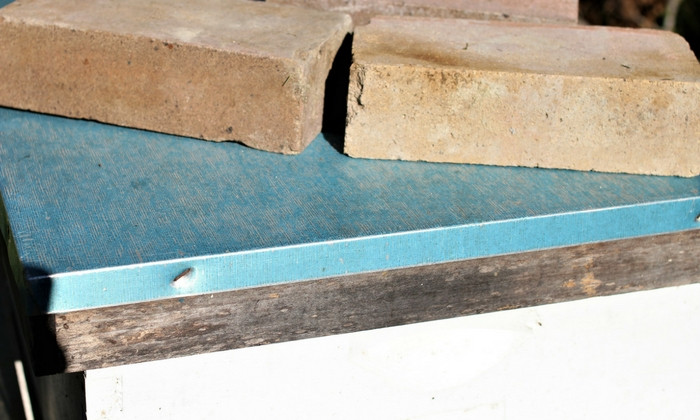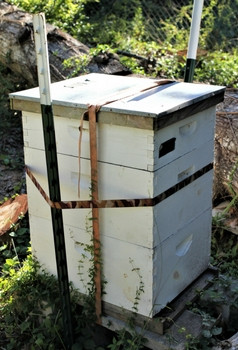Spring rain, while vital for rejuvenating landscapes and nurturing new growth, can present unique challenges for certain creatures, especially bees. Beekeepers often observe the skies with a keen interest, wondering how these essential pollinators cope with wet conditions. The question naturally arises: Can Bees Fly In The Rain?
The straightforward answer is yes, bees possess the capability to fly in the rain, but it’s far from ideal and generally avoided. Rainy weather introduces significant hazards that can impede their flight and endanger their well-being. Even a light mist can pose problems, as moisture accumulates on a bee’s body, disrupting its delicate flight dynamics.
The Science of Bee Flight in Rain
Understanding why bees struggle in the rain requires a look at the physics of their flight. Bees are marvels of aerodynamic efficiency, with wings beating at an incredible rate of approximately 12,000 times per minute. This rapid wing movement allows them to generate lift and navigate through the air. However, rain introduces several factors that compromise this finely tuned system.
Firstly, water accumulation on a bee’s body and wings adds weight. Even small amounts of water can become a significant burden for a creature as light as a bee, forcing it to expend more energy to stay airborne. This added weight also interferes with the wing’s mechanics, making each beat less effective.
Secondly, raindrops themselves pose a direct physical threat. Large raindrops hitting a bee in flight can be akin to being struck by a miniature water projectile. The force of these impacts can knock a bee out of the sky, leaving it vulnerable and disoriented.
Furthermore, moisture disrupts the insulation provided by the fine hairs covering a bee’s body. These hairs are crucial for maintaining body temperature, and when wet, they lose their insulating properties. This can lead to chilling, especially in cooler rainy conditions, further hindering flight and overall bee activity.
Bee Behavior During Rainy Weather
Faced with these challenges, bees have developed natural behaviors to cope with and avoid rainy weather.
Seeking Shelter
If a bee is caught outside the hive when rain begins, its immediate instinct is to seek shelter. They will look for temporary refuge under leaves, flowers, or any available crevice that offers protection from the downpour. They will remain in these sheltered spots until the rain subsides and conditions become more favorable for flight.
Hive Preparation
Anticipating inclement weather, bees proactively prepare their hive. One crucial behavior is reinforcing the hive structure with propolis. Propolis, a resinous substance collected from trees, acts as a natural sealant and glue. Bees meticulously fill any cracks and crevices in the hive with propolis, strengthening its defenses against rain and wind penetration. This is particularly important for newer hives, as they may not be as thoroughly sealed as established ones.
 Beehive secured with bricks for storm protection, showcasing propolis use by bees.
Beehive secured with bricks for storm protection, showcasing propolis use by bees.
Reduced Foraging Activity
One of the most noticeable changes in bee behavior before and during a storm is a significant decrease in foraging activity. Forager bees, responsible for collecting nectar and pollen, instinctively stay inside the hive as storm clouds gather. If foragers are already out when rain begins, they will rapidly return to the hive and cease further excursions. This reduced activity at the hive entrance is a clear sign that bees are aware of the impending weather change.
In-Hive Tasks
With more bees staying inside during rainy periods, the colony shifts its focus to internal tasks. Forager bees, now confined to the hive, are reassigned to crucial roles such as regulating humidity and temperature within the hive, caring for the brood (larvae), and managing food stores. This internal reorganization ensures the colony’s continued well-being even when external conditions are unfavorable.
Prolonged periods of rain, however, can create stress on the colony’s food reserves. If rainy weather persists for weeks, especially following a honey harvest, beekeepers need to monitor the hive’s food supply closely.
How Beekeepers Can Help Bees in Rainy Seasons and Storms
While bees are naturally equipped to handle typical spring showers, beekeepers can take proactive steps to assist their colonies, especially during more severe or prolonged rainy periods.
Hive Security
Ensuring the physical security of the hive is paramount, particularly during storms with strong winds. A full hive, laden with honey, is considerably heavy, which provides some natural stability. However, strong winds can still topple hives or dislodge the lid, allowing rain to enter and damage the hive’s interior.
In areas prone to hurricanes or tornadoes, robust hive securing measures are essential. This can involve using straps to bind hive components together and anchoring the hive to the ground using T-posts or other sturdy supports.
Even in areas with less extreme weather, weighting down the hive cover with bricks or stones is a simple yet effective way to prevent it from being blown off by strong gusts of wind, thus keeping the hive dry. Straps or latches can also be used to further secure hive components together.
 Beehive strapped to T-posts for hurricane protection, demonstrating secure hive setup.
Beehive strapped to T-posts for hurricane protection, demonstrating secure hive setup.
Food Supply Monitoring and Supplemental Feeding
Extended rainy periods limit bees’ ability to forage for nectar and pollen. If rain persists for days or weeks, especially after honey has been harvested, the colony may deplete its food reserves. Beekeepers should regularly check honey stores during prolonged wet spells.
If food supplies are running low, supplemental feeding becomes necessary. Providing fondant or sugar syrup can bridge the gap until foraging conditions improve. Knowing how to prepare fondant for bees is a valuable skill for beekeepers in regions with unpredictable spring weather. Once the weather clears and bees resume collecting nectar and pollen, supplemental feeding can be discontinued.
Strategic Hive Placement
When possible, positioning hives in locations that offer some natural shelter can be beneficial. Placing hives near barns, houses, or even dense tree lines (while ensuring flight paths remain clear) can provide a degree of protection from wind and rain. If a hive needs to be moved slightly for better shelter, ensure it’s only moved a short distance so returning foragers can still locate their hive.
In conclusion, while bees can technically fly in the rain, they instinctively avoid it due to the inherent dangers. They possess remarkable adaptations to weather storms, both individually and as a colony. Beekeepers, by understanding these adaptations and taking proactive measures to secure hives and monitor food supplies, can further support their bees in weathering spring rains and ensuring the continued health and productivity of their colonies. Observant beekeeping and timely responses to environmental conditions remain key to successful beekeeping practices.